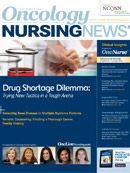The Oncology Drug Shortage: At Practice Level, Shortages Become Personal and Painful
Providing oncology care is in itself intense and challenging, and the ongoing shortage of oncology drugs has made clinical practice even more challenging as we deal with the shortage on a very personal level.
Lisa Schulmeister, RN, MN, APRN-BC, OCN®, FAAN
Editor-in-Chief OncLive Nursing
Oncology Nursing Consultant, Adjunct Assistant Professor of Nursing Louisiana State Health Sciences Center in New Orleans, Louisiana
Providing oncology care is in itself intense and challenging, and the ongoing shortage of oncology drugs has made clinical practice even more challenging as we deal with the shortage on a very personal level. We’ve had national drug shortages for years, but it has only been fairly recently that we—and our patients—have really felt the impact.
We all remember the first time or two that we heard that an oncology drug was in short supply. It was a time of disbelief that left us wondering how a drug that had been around for ages was now unavailable. Sometimes we were fortunate to find someplace willing to share its stock of a needed drug, but as time passed, pharmacy shelves were depleted and some oncology drugs were not available anywhere. This led to the beginning of the painful decision era, as prescribers had to consider drug substitution or dropping a drug from a treatment regimen. These decisions, in turn, created a lot of anxiety for our patients and put us in the unenviable position of telling our patients that we don’t know if the treatment will be as effective with a substituted drug or without the needed drug.
Patients and their families also have had a hard time grasping the idea that a needed oncology drug is simply not available. As one patient said, “I can’t believe this is happening in 2012, here in the USA, in the land of plenty.” I think we all felt a sense of frustration and helplessness, because aside from “calling our member of Congress” (a common recommendation at the start of the shortage), there really was little we could do personally to resolve the shortage.
It’s intensely personal to care for patients who are expecting established, evidence-based cancer treatment, but have their hopes dashed when needed drugs are available one day and unavailable the next.
It was, and still is, intensely personal to care for patients who are expecting established, evidence-based cancer treatment, but have their hopes dashed when needed drugs are available one day and unavailable the next. The drug shortage has made chess players out of us, as we try to anticipate when a drug will again be available. We’re also now clairvoyants and chemists as we contemplate drug substitutions and predict how patients might respond. In the end, the oncology drug shortage has radically changed our practice and how well (or how inadequately) our patients have been treated.
We’re now hearing accounts of patients who have died, or have had disease recurrence or progression that have been attributed to the oncology drug shortage. These stories have received a great deal of media attention, and they should. The drug shortage now has the faces of real people, making the situation more personal to government officials, manufacturers, and all who have contributed to the drug shortage. It’s been personal to those of us who are clinicians from the start.
Although reports of active drug shortages declined 14% between 2011 and 2012, 211 drugs remain unavailable or in short supply. In order to track the drug supply, the private and nonprofit sectors have created online information resources, such as the American Society of Health-System Pharmacists website (www.ashp.org/ shortages) and the FDA drug shortage website (http://www.fda.gov/Drugs/DrugSafety/DrugShortages/default.htm). Organizations, such as the advocacy organization Fight Colorectal Cancer (http://fightcolorectalcancer.org/), are providing information, such as “What to do when your doc is out of 5-FU” to inform and empower patients.
Manufacturing problems are believed to be responsible for more than half of all drug shortages, and manufacturers are now required to alert the FDA 6 months in advance when drugs are discontinued or supply disruption is anticipated. In February 2012, the FDA also approved the importation of some drugs, such as Lipodox from the Indian manufacturer Sun Pharma Global. Hopefully, a combination of awareness, legislation, and action will put an end to the oncology drug shortage, and we will never again have to tell patients that lifesaving drugs are not available.





